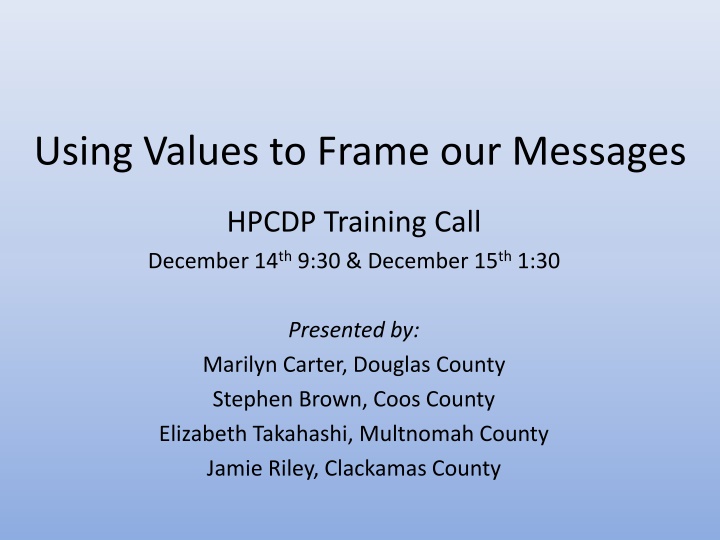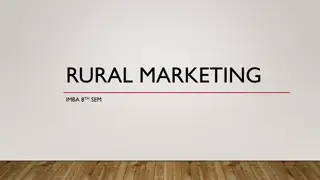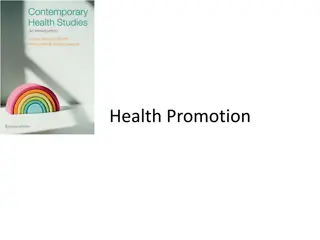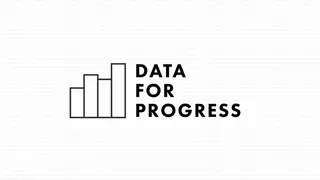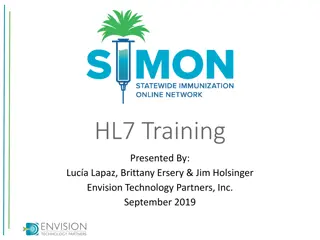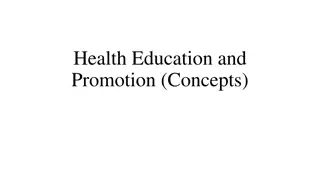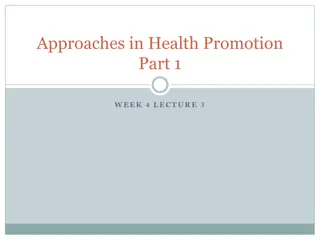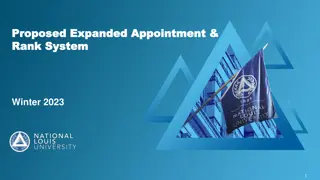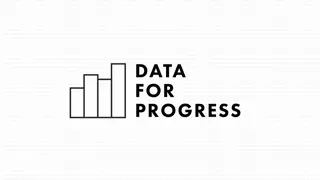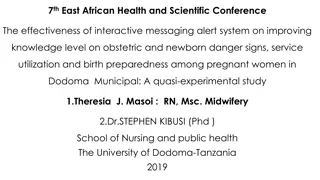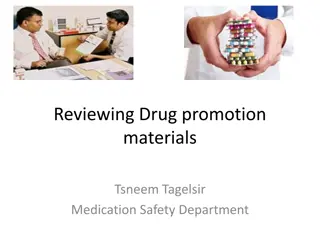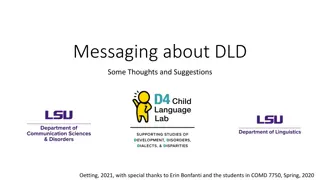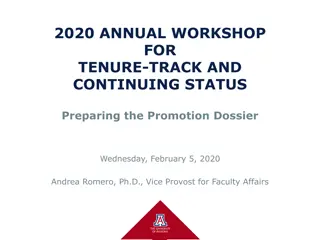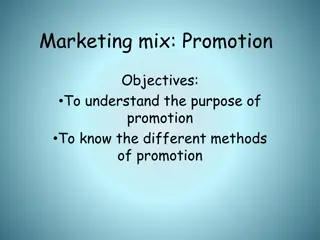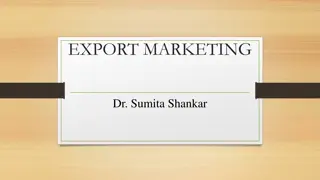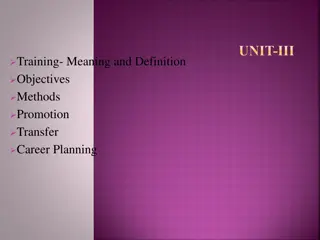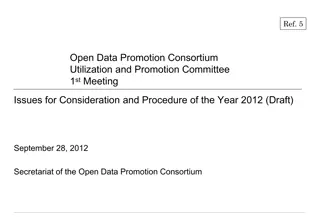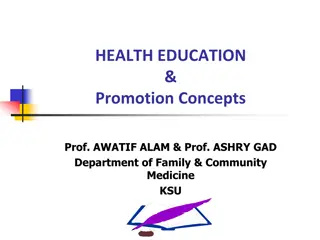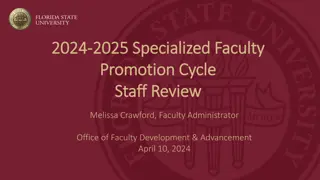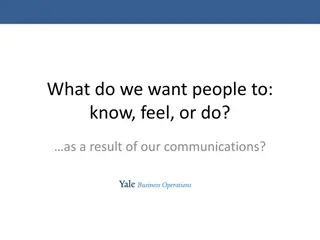Effective Messaging Strategies for Health Promotion Training
Explore the importance of values-based messaging, framing objectives, and the impact of framing in communication strategies for public health and community development. Learn about the seven stages of frameworks learning and how to effectively deliver messages to support policy changes. Gain insights on avoiding reinforcing opposing values, storytelling techniques using social math, and finding relevant tools and resources for framing messages.
Download Presentation

Please find below an Image/Link to download the presentation.
The content on the website is provided AS IS for your information and personal use only. It may not be sold, licensed, or shared on other websites without obtaining consent from the author.If you encounter any issues during the download, it is possible that the publisher has removed the file from their server.
You are allowed to download the files provided on this website for personal or commercial use, subject to the condition that they are used lawfully. All files are the property of their respective owners.
The content on the website is provided AS IS for your information and personal use only. It may not be sold, licensed, or shared on other websites without obtaining consent from the author.
E N D
Presentation Transcript
Using Values to Frame our Messages HPCDP Training Call December 14th9:30 & December 15th1:30 Presented by: Marilyn Carter, Douglas County Stephen Brown, Coos County Elizabeth Takahashi, Multnomah County Jamie Riley, Clackamas County
Special Thanks To Liana Winett, Dr.P.H., C.H.E.S Research Associate Professor Portland State University College of Urban & Public Affairs: School of Community Health Janet Byrd, MA Urban & Environmental Policy and Planning Executive Director Neighborhood Partnerships Portland, Oregon
Objectives Learn about values-based messaging and how to avoid reinforcing opposing values Apply message framing to TPEP and Healthy Communities issues Learn how tell a story using social math Learn where to find tools and resources on framing
Why Framing Matters Framing Objective Example To ground our issue in shared values I have the right to smoke . . . About 80% of adults who smoke started before the age of 18, we have a responsibility to... To move from an individual solution to a policy solution It s a parent s responsibility to . . . Making healthy choices are more difficult when unhealthy choices are the most accessible, most affordable, and most heavily marketed To respond to challenges and opposing views We don t need government telling us We rely on our public institutions to set and enforce the regulations that will protect us from physical and financial harm To build understanding and support for policy change We don t need a policy to tell us what to eat at work Smart workplaces have been able to implement effective policies and programs to improve the health of their employees, saving money and lives in the long run. If they can get you asking the wrong questions, they don t have to worry about the answers. Thomas Pynchon
The Seven Stages of FrameWorks Learning Adapted from Jeanne Ryer, Endowment for Health, New Hampshire 1. Denial, you can't believe that what you've done in the past doesn't work, even though you know better, and can only dimly see how you might do it differently. 2. Wonder and Ah-Ha!, suddenly everything you see is Framing! Framing! Framing! 3. Paralysis, you are afraid to frame because you know the bad frames are in you. 4. Assimilation, you hunker down, read and think more, and try to learn how to get yourself unstuck. 5. Awkwardness, your frame has the head of a cat and the tail of a dog, but you recognize it and keep trying. 6. Integration, you successfully reframe a piece and it works, and you keep doing it, and it works better. 7. Conversion, you realize that you had better share your knowledge with your colleagues and coalitions or their frames will undermine yours. It s like learning another language, Robin Hausen, Josephine County
Words Create Worlds http://www.youtube.com/watch?v=9YSXK7boXtI
Opposing Frames Market Justice (Dominant) Social Justice Shared responsibility Strong obligation to collective good Unequal starting positions require remedy Focus on social conditions Basic benefits should be assured Community well-being supersedes individual well-being Government involvement necessary Self-determination/Self discipline Rugged individualism Benefits based solely on effort Limited obligation to collective good Neutrality of major social institutions Voluntary and moral nature of behavior Limited government intervention Personal responsibility
Frame Levels Level 1: Big Ideas (Values) opportunity, equality, justice, protection, prosperity Level 2: Issues housing, environment, public health, children, education Level 3: Policies worksite wellness, tobacco
Leading with a Level One Value Every child should have access to immunizations but too many families in our community are not bringing their children in to our clinics. This is why we are proposing a new agency rule requiring more clinic hours . . . The health of the whole community is protected when we ensure that our children are immunized. One of the ways we do this is through our public health agencies that provide free and low cost immunizations for all children. We need extended clinic hours to keep up with growing demands.
Tell Landscape Stories, Not Portrait Stories Portraits Landscapes Issues Trends Public Appeal to citizens Better Policies Fix the Condition Individuals Events Private Appeal to consumers Better information Fix the person - Based on work by Iyengar and Gilliam
Portrait/Landscape Last month, an 8-year-old Ohio boy was removed from his family home and placed in foster care not because of physical abuse, but because the third-grader weighed more than 200 pounds. County case workers argued that the boy s mother was engaging in medical neglect by not getting his weight... Being healthy and fit in adulthood is largely determined by the communities that we live in as children. The decisions made in our states and nation about child nutrition programs affect these communities, which then shape the lives of the children who live there.
Remove from your vocabulary This is not about We are not This can be an issue of ____, but . We don t intend to ____, rather ..
Reinforcing the Opposing Frame "The governor is not talking about taking away people's French fries. He just wants to offer them the choice of having carrots." Oregon's governor wants healthier state work force, but vendors say don't take the Snickers (The Oregonian, 10/6/10) Hookah lounges promote a social norm that smoking is cool and safe Hookah smokers say doctors are too huffy (The Hillsboro Argus, 11/16/10)
Problem Focus Solution Focus Food insecurity is one of the most pressing problems facing our community. In 2010, XX% of households in the greater Metro area reported being unable to access sufficient food at all times. Children suffering hunger on a regular basis experience growth problems, higher rates of obesity, are more susceptible to infectious disease, miss more days of school, and demonstrate poor academic performance. Parents struggling to put food on the table also experience greater illness, emotional and psychological distress, and more missed days of work. By ensuring reliable access to safe and healthy food, families can build better lives and our communities will be stronger. We know that communities are stronger when families have access to the safe, healthy food needed to meet basic needs and fuel active lives. With sufficient food every day, children perform better in school, parents can be more productive at work, and families can fully participate in and feel a part of their communities. It is for this reason that the public sector must work together with nonprofit organizations and private funders to ensure that every family enjoys the security of having its basic nutritional needs met.
Importance of Social Math According to the [TPEP] fact sheet, 5,246 adults in Crook County regularly smoke cigarettes in one year. Regarding serious illness caused by tobacco use, 1270 suffer in the county per year. An average of 65 people dies from tobacco- use each year, and $10 million is spent on medical care for tobacco-related deaths. In 2009, 27 percent of adults were smokers, compared to 19 percent statewide and 15 percent of males used smokeless tobacco, compared to 6 percent statewide. There were 13 percent of eighth graders that used cigarettes in Crook County, compared to nine percent statewide, and 22 percent of 11th graders, compared to 17 percent statewide. 12 percent of 8th grade males used smokeless tobacco in Crook County, and 19 percent of 11th grade males. Local cigarette use exceeding state average: Central Oregonian, 8/26/10
Constructing Social Math Convert large numbers into images that people can relate to. Break down numbers by time Break down numbers by place Provide comparisons with familiar things Provide ironic comparisons Personalize numbers News For Change, 1999
Social Math Examples The number of tobacco deaths in the U.S. per year is equal to three fully loaded 747 jets crashing every day with no survivors. The tobacco industry spends more money promoting smoking in a week than the entire federal government spends on preventing smoking in a year.
Tone is a Frame Signal Highly rhetorical and angry tone can unnecessarily polarize and partisan-ize Tends to set up a defensive or fight back response Raises suspicion of motivation Using pragmatic and reasonable tone can keep listening and learning open
Negative Tone Positive Tone Greedy developers have their sights set on a 50 acre parcel of land in the middle of Westwood. Unless government steps in, all we ll get there is more expensive housing and big box stores that exclude the poor and powerless in our community. Our communities are strongest when economic development works for everyone. We need to use our public systems and structures to ensure that new development in Westwood benefits the entire community. It is time for an inclusive planning process to . . .
Language Words to avoid Words to use Smokers People who smoke, people who use tobacco Homeless People who don t have a place to live right now. Poverty Families who cannot afford the basics in life Refugees and immigrants People seeking a new home in the U.S. Trial lawyers Public Protection Attorneys
Strategic Value-Based Framing Identify Vision (our shared goal). Identify Values (why it matters). What is the problem? Solution (specific policy).
Multnomah County Worksite Wellness Op-Ed: Prevention cheaper than treatment
The Vision (Shared Goal) Our goal: to highlight strategies that can help employers keep their workforce as healthy as possible. Employers and businesses are vital to the health of our region.
Values (Why it matters) A small effort invested upstream (prevention through public & private partnerships) will result in great savings as well as healthier, happier lives.
The Problem Oregon employers are struggling with the high cost of providing health care for their employees and themselves.
The Solution We wanted to bring together the public and private sectors to develop shared worksite wellness goals. We can learn from one another, and we want results that can benefit businesses, communities and citizens across the Metro region.
Making No Smoking Policies Work in Affordable Housing A collaboration of: Clackamas, Multnomah, Washington Counties, Health In Sight, LLC and Clark County, WA
Vision (Shared Goal) Everyone lives in safe & healthy housing
Values (Why It Matters) It is our responsibility as housing providers to protect our residents, particularly the most vulnerable, from exposure to secondhand smoke.
The Problem Children and residents with chronic diseases are living in buildings where secondhand smoke permeates walls and absorbs into furniture, carpet, and clothing.
Solution Instead of: The only way to effectively eliminate exposure to secondhand smoke is for us to prohibit smoking indoors. Try: We can ensure families live in homes where they are free from secondhand smoke exposure by implementing no smoking policies.
Resources Frameworks Institute www.frameworksinstitute.org/overviewtools.html Topos on Framing www.topospartnership.com/topos-on-framing A New Way to Talk About the Social Determinants of Health www.rwjf.org/vulnerablepopulations/ More Than a Message: Framing Public Health Advocacy www.bmsg.org/documents/6HEB-Dorfman.pdf Framing Tobacco Control Efforts Within an Ethical Context, B.J. Fox http://tobaccocontrol.bmj.com/content/14/suppl_2/ii38.full Berkley Media Group www.bmsg.org Demos website Power Points to communicate the role of government http://sites.google.com/site/demospublicworks/presentation-slides-2
